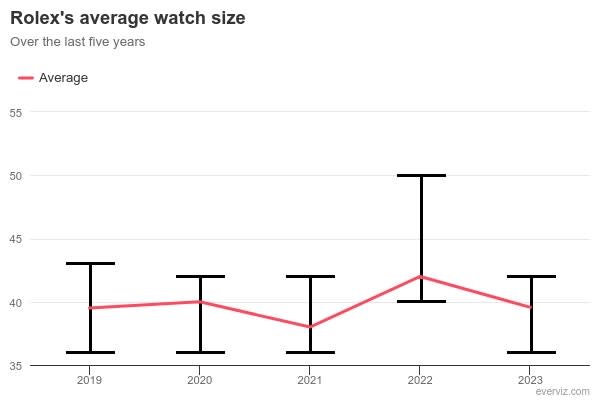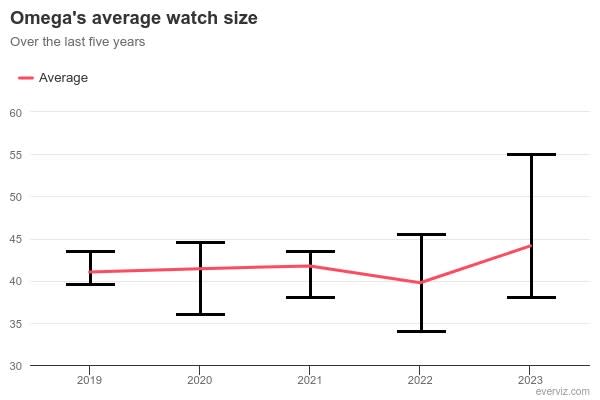Are Watches Actually Getting Smaller?

Photographs: Getty Images, Audemars Piguet, Omega; Collage: Gabe Conte
This is an edition of the newsletter Box + Papers, Cam Wolf’s weekly deep dive into the world of watches. Sign up here.
Last month, we wrapped up 2023 with our very fun, second annual GQ Watch Survey. Forty-six members of the Watch Illuminati weighed in on the best brand, watch, and collector of the year. And despite busting out my new Max Büsser-themed monthly calendar for 2024, there was one takeaway from the survey I couldn’t get off my mind. Nearly everyone seemed to agree that slimmed-down watches were taking over: collectors were wearing them with greater frequency and watchmakers were making more of them. So, I set out to investigate: Are watches actually getting smaller?
To figure this out, I collected data from the biggest men’s releases over the past five years—over 230 in all!—from the five top watch brands, according to Morgan Stanley’s most recent annual report. (I skipped over Cartier because of its long commitment to the small-watch way). The argument I’ve heard a lot is that as traditionally smaller vintage watches continue to be the apple of so many collectors’ eyes, the Swiss titans have used these as inspiration to downsize their modern releases.
It’s also no secret that many passionate collectors want smaller watches. Mark Cho of The Armoury conducted a survey on watch sizes over multiple years and many of the 2,400 respondents believe they have dainty wrists and therefore want teenier tickers. The most desirable size for Cho’s respondents was a slender 36 millimeters! Still, Cho expressed skepticism that anything would change or was changing: “I actually wonder if brands think about it at all because, to them, stuff is selling just fine so why bother?” he said last year. Looking at the—admittedly non-exhaustive—data I collected, that instinct is right on. Here’s the graph charting out the size of watches released from since 2019:

When taken as a whole, not much has changed in terms of the average watch size. Since 2019, average diameters have decreased juuuust ever so slightly from 41.1 to 40.5mm in 2023 (I’m excluding Omega’s gargantuan 55mm Ploprof from the recent average because it was such an outlier).
In fact, almost none of the brands I looked at meaningfully reduced the size of their watches over that period. There are basically straight lines running through Rolex, Omega, Patek Philippe, and Audemars Piguet’s charts.




Despite the virtually unchanged averages, there were hints that some brands were trying to toss more bones to the smaller-watch crowd. For instance, the range on Patek Philippe’s watches shaved off the high-end and expanded towards the smaller stuff.
IWC is the one brand that’s made significantly smaller pieces since 2019. The chart for the maker, best known for its huge pilot watches, actually features a noticeable downslope as it moves into the 2020s:

The brand’s releases in 2019 focused on historically accurate pilot watches, which were made large for extra legibility in the cockpit. Those pieces often clocked in at over 45mm! But IWC said phooey to traditional sizing over the past few years. Its Pilot’s Watch got downsized to 41mm and the brand released the crowd-pleasing Mark XX in a very wearable 40mm. In 2023, the brand only put out one piece larger than 41mm (compared to NINE in 2019). It so badly wanted to keep to this smaller size that its 2023 release the Pilot’s Watch Chronograph 41 actually measured in at 41.9! I didn’t survey all of Panerai’s famously huge releases, but it’s also notably expanding its range of pint-sized pieces.
There are two main conclusions to draw from this data. The first is that really big watches are largely being phased out. IWC’s turn towards the friendlier low-40s speaks volumes about the market for pieces rumbling closer to 50. Audemars Piguet, meanwhile pushed its Code 11:59 down from 41mm to 38mm, and its premier releases with collaborators like Travis Scott and Alyx’s Matthew Williams started at 37mm and didn’t go beyond 41mm.
The second takeaway? The fact that the overall average remained stagnant tells me the pieces we hold up as examples of shrinkage are really just new ends of a widening range. Tudor’s Black Bay 54, for instance, came in at the nerd-approved 37mm, while the brand’s other new sport watches came in at 41, 42, and 43mm. Maybe it’s not necessarily that all watches are downsizing, but that there’s now a far greater variety of available sizes. As Cho told me last year, “it's a very similar situation to selling clothing. You stock multiple sizes of a shirt because people come in all shapes and sizes.” Watch collectors will take that shift.
See all of our newsletters, including Box + Papers, here.
Originally Appeared on GQ

